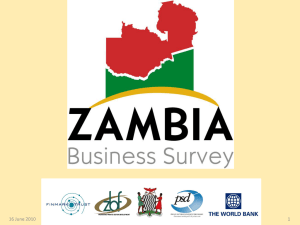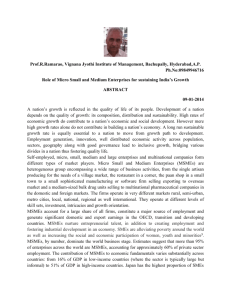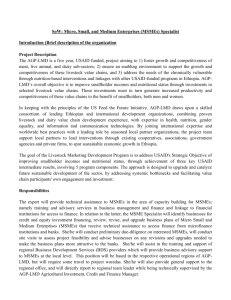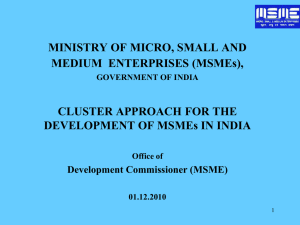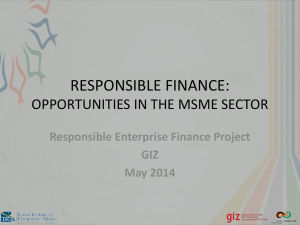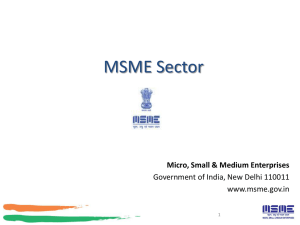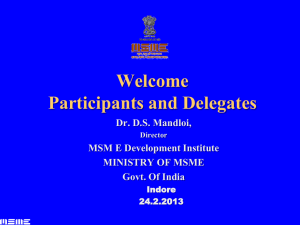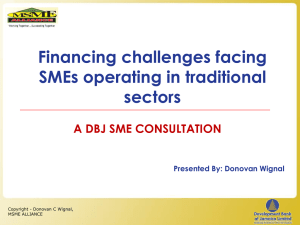PROBLEMS AND PROSPECTS OF MICRO, SMALL AND MEDIUM
advertisement
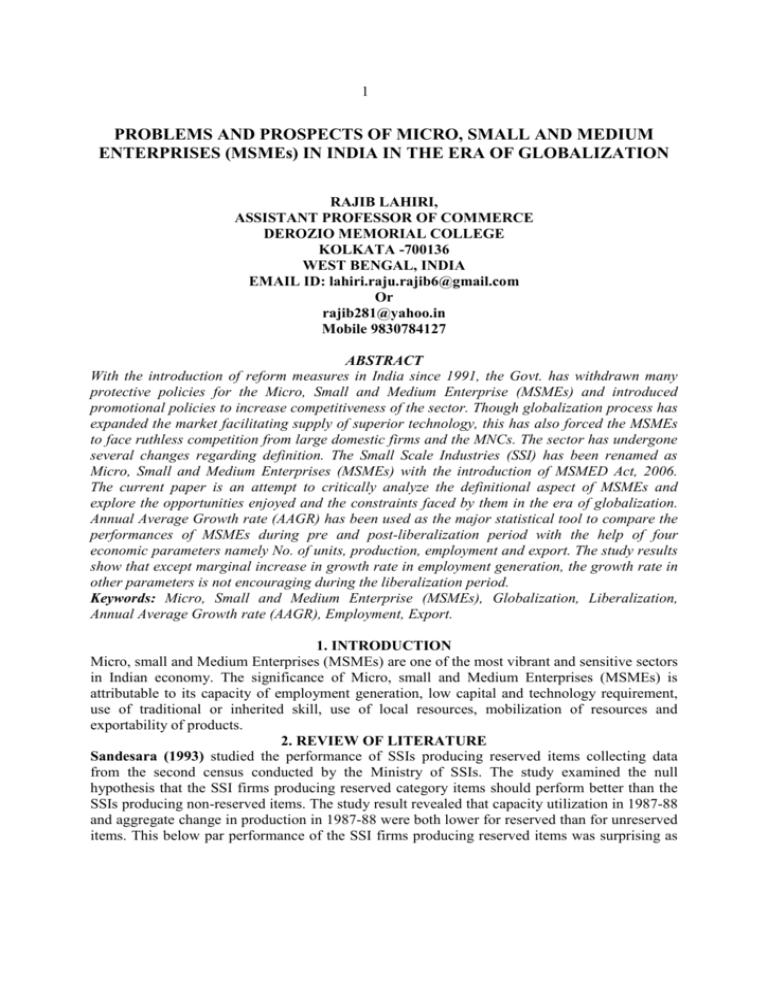
1
PROBLEMS AND PROSPECTS OF MICRO, SMALL AND MEDIUM
ENTERPRISES (MSMEs) IN INDIA IN THE ERA OF GLOBALIZATION
RAJIB LAHIRI,
ASSISTANT PROFESSOR OF COMMERCE
DEROZIO MEMORIAL COLLEGE
KOLKATA -700136
WEST BENGAL, INDIA
EMAIL ID: lahiri.raju.rajib6@gmail.com
Or
rajib281@yahoo.in
Mobile 9830784127
ABSTRACT
With the introduction of reform measures in India since 1991, the Govt. has withdrawn many
protective policies for the Micro, Small and Medium Enterprise (MSMEs) and introduced
promotional policies to increase competitiveness of the sector. Though globalization process has
expanded the market facilitating supply of superior technology, this has also forced the MSMEs
to face ruthless competition from large domestic firms and the MNCs. The sector has undergone
several changes regarding definition. The Small Scale Industries (SSI) has been renamed as
Micro, Small and Medium Enterprises (MSMEs) with the introduction of MSMED Act, 2006.
The current paper is an attempt to critically analyze the definitional aspect of MSMEs and
explore the opportunities enjoyed and the constraints faced by them in the era of globalization.
Annual Average Growth rate (AAGR) has been used as the major statistical tool to compare the
performances of MSMEs during pre and post-liberalization period with the help of four
economic parameters namely No. of units, production, employment and export. The study results
show that except marginal increase in growth rate in employment generation, the growth rate in
other parameters is not encouraging during the liberalization period.
Keywords: Micro, Small and Medium Enterprise (MSMEs), Globalization, Liberalization,
Annual Average Growth rate (AAGR), Employment, Export.
1. INTRODUCTION
Micro, small and Medium Enterprises (MSMEs) are one of the most vibrant and sensitive sectors
in Indian economy. The significance of Micro, small and Medium Enterprises (MSMEs) is
attributable to its capacity of employment generation, low capital and technology requirement,
use of traditional or inherited skill, use of local resources, mobilization of resources and
exportability of products.
2. REVIEW OF LITERATURE
Sandesara (1993) studied the performance of SSIs producing reserved items collecting data
from the second census conducted by the Ministry of SSIs. The study examined the null
hypothesis that the SSI firms producing reserved category items should perform better than the
SSIs producing non-reserved items. The study result revealed that capacity utilization in 1987-88
and aggregate change in production in 1987-88 were both lower for reserved than for unreserved
items. This below par performance of the SSI firms producing reserved items was surprising as
2
those firms did not have to face competition from the large firms. The author observed that this
could be due to the entrance of excess SSI firms into the protected areas.
Sonia and Kansai Rajeev (2009) studied the effects of globalization on Micro, Small and
Medium Enterprises (MSMEs) during pre and post liberalization from 1973-74 to 2008-09. They
used four economic parameters namely number of units, production, employment and export and
interpreted study results based on Annual Average Growth Rate (AAGR) calculation. AAGR in
pre liberalization period (1973-74 to 1989-90) was higher in all selected parameters than that of
post liberalization period (1991-92 to 2007-08). They concluded that MSMEs failed to put up an
impressive performance in post reform era.
Bhavani T.A. (2010) highlights the issue of quality employment generation by the SSIs and
negates the short term attitude of increasing the volume of employment generation
compromising with quality. The author argues that employment generation by the SSIs may be
high in quantitative term but very low in quality. Technological upgradation would enable the
small firms to create quality employment improving remuneration, duration and skill. This
structural shift may reduce the rate of employment generation in the short run but would ensure
high-income employment generation in the long run
Subrahmanya Bala (2011) has probed the impact of globalization on the exports potentials of
the small enterprises. The study shows that share of SSI export in total export has increased in
protection period but remain more or less stagnated during the liberalization period. However,
the correlation co-efficient in liberalization period is higher than that of protection period
suggesting that the relationship between the total export and SSI export has become stronger in
liberalization period. This may be due to the drastic change in composition of SSI export items
from traditional to non-traditional and growth in its contribution to total export through trading
houses, export houses and subcontracting relation with large enterprises. Thus, the current policy
of increasing competitiveness through infusion of improved technology, finance, and marketing
techniques should be emphasized.
3. OBJECTIVE OF THE STUDY
The major objectives of the study are as follows:
1) To examine the changing pattern of definition of the Micro, Small and Medium
Enterprises (MSMEs) in India and critically analyse the impact of Micro, Small and
Medium Enterprise Development (MSMED) Act, 2006.
2) To analyse the opportunities and threats of MSMEs in India during the liberalization
period
3) To analyse the performance of MSMEs in India during the pre and post liberalization
period.
4. DATABASE AND METHODOLOGY
Data used in the study are secondary in nature and mostly collected from the Annual Reports
published by the Ministry of Micro, Small and Medium Enterprises. The study covers a period
from 1973-74 to 2009-10. Four parameters namely No. of units, production, employment and
export have been used for performance analysis of MSMEs during pre and post liberalization
period. I have started from 1973-74 because the first census for the MSMEs in India was
initiated during 1973-74 and no authentic data about the small enterprises was available prior to
this period.
3
5. ANALYSIS
Govt. policies regarding Micro, Small and Medium Enterprises (MSMEs)
After independence, the Govt. took up the policy of accelerating industrialization since Second
Five Year Plan. The Policy resolution 1948 emphasized that cottage and small-scale industries
can ensure best utilization of local resources, achieve ‘local-self-sufficiency’ in production,
increase employment generation through rehabilitation of displaced persons and ensure balanced
economic growth. Industrial Policy Statement 1977 introduced the concept of District Industries
Centers (DICs) for SSIs to ensure supply of raw materials and machinery, market survey of the
district, generating new business ideas, arrangement of credit facility, maintenance of quality of
products etc. The Industrial Policy Statement 1980 took some path breaking measures like
increase in Investment limit for tiny, small, and ancillary units, withdrawal of industrial location
restriction, elimination of provisions regarding expansion, increase in private participation.
The New Industrial Policy in 1991 emphasized on raising the investment ceiling for the purpose
of definition of a small unit to 6 million ( Rs 7.5 million if the unit concerned undertakes to
export 30 percent of its output or if it is an ancillary unit i.e. a firm supplying at least 50 percent
of its output to large scale industries) , allowing other investors (including large-scale enterprises
and foreign investors) 24 percent equity participation in a small-scale unit, introduction of the
Act on delayed payment to small and ancillary enterprises, encouraging banks to open
specialized SSI Branches and giving better priority to the sector in their annual credit budgets .
Comprehensive Policy Package for SSIs and Tiny Sector 2000 increased the exemption for
excise duty limit from 50 lakhs to Rs One crore to increase competitiveness, conducted the third
census of small-scale industries and motivated the SSI associations to develop and operate
testing laboratories. As per the Policy Package for SME 2005-06 Small and Medium Enterprises
were recognized in the services sector, and treated at par with SSIs in the manufacturing sector
and emphasized on Cluster Development Model.
Definitional Aspect of Micro, Small and Medium Enterprises (MSMEs)
The definition of Small Scale Industries has undergone changes for many times. The main
criterion for definition was mainly the investment level and number of employees. The chart
below shows the changing pattern of SSI definition.
Changing pattern of Investments in SSIs
YEAR
INVESTMENT LIMIT (Rs.)
1950
Up to Rs. 0.5 million in fixed assets
1966
Up to Rs. 0.75 million in Plant & Machinery
1975
Up to Rs. 1 million in Plant & Machinery
1980
Up to Rs. 2 million in Plant & Machinery
1985
Up to Rs. 3.5 million in Plant & Machinery
1991
Up to Rs. 6 million in Plant & Machinery
1997
Up to Rs. 10 million in Plant & Machinery
1999`
Up to Rs. 30 million in Plant & Machinery
Source: Ministry of Small Scale Industries
A major change took place in 2006 with the enactment of MSME Development Act, 2006.
In accordance with the provision of Micro, Small & Medium Enterprises Development
(MSMED) Act, 2006 the Micro, Small and Medium Enterprises (MSME) are classified into two
categories.
4
(a) Manufacturing Enterprises- The enterprises engaged in the manufacture or production of
goods pertaining to any industry specified in the first schedule to the industries (Development
and regulation) Act, 1951. The Manufacturing Enterprise is defined in terms of investment level
in plant & machinery.
(b) Service Enterprises: The enterprises engaged in providing or rendering of services and
are defined in terms of investment in equipment.
The limit for investment in plant and machinery / equipment for manufacturing / service
enterprises, as notified are as under:
Manufacturing Sector
Enterprises
Investment in plant & machinery
Micro Enterprises
Does not exceed twenty five lakh rupees
Small Enterprises
More than twenty five lakh rupees but does not exceed five crore
rupees
Medium Enterprises
More than five crore rupees but does not exceed ten crore rupees
Service Sector
Enterprises
Investment in equipments
Micro Enterprises
Does not exceed ten lakh rupees:
Small Enterprises
More than ten lakh rupees but does not exceed two crore rupees
Medium Enterprises
More than two crore rupees but does not exceed five core rupees
Source: MSME Development Act 2006, Ministry of the District Industry Centers (DIC)
MSME, Government of India.
Importance of MSME Development Act, 2006
With the introduction of new MSME Act 2006, the Govt. has tried to resolve some major issues
related to the MSMEs like complicated bureaucratic registration procedures, lack of finance, lack
of managerial skills etc. The most important thing the Act has done is to increase the significance
of the sector and to offer a clear definition of MSMEs.
Further, the act mandated the composition of the National Board of MSME8 with clear long run
objective of overseeing and regulating the development of micro, small and medium enterprises
in India. The broad functions of this board are to manage cluster development, train
entrepreneurs, develop infrastructure and promote financial access to this sector.
The MSME Act 2006 has frame worked a strict rule regarding payment of dues by increasing
penalties substantially for delay in payment. For example, the Act mandates that all payments be
made within 45 days failing which the creditor must pay compound Interest which is higher than
the bank rate notified by the RBI.
As noted in section 2.1, registration in the MSME sector is voluntary and unregistered firms
constitute a significant proportion of the total firms constitute a significant proportion of the
total. As a result, proper maintenance of records becomes extremely difficult. The new MSME
Development Act 2006 has made the registration procedure much simple and less time taking.
Debatable issues initiated by the MSME Development Act, 2006
Two policies introduced by the MSMED Act, 2006 have initiated much debate. One is proposed
Procurement Preference Policy and the other is Exit Policy or a Close of Business (COB) policy.
The first policy will determine how much supplies should be purchased by the Govt. agencies
from the MSMEs and the second policy will determine when and how to close a sick MSME
unit.
5
The first policy tends to create a cold war between the small and medium enterprises. The
Federation of Associations of Cottage and Small Industries (FACSI) has placed a demand for a
separate policy exclusively for the small units regarding the purchase of supplies. Many womenrun small and cottage industries have asked for separate quota for themselves. Thus, the issue has
taken a complicated shape.
Regarding the Close of Business (COB) two major issues remain unsettled. The first one is at
what level The Govt. should intervene to close a sick MSME unit. The second issue is about the
relative priorities of different parties associated with the MSME units like owners, shareholders
and employees, in case of conflict.
The Act has expanded the investment range and has clubbed small and medium enterprises. In
the process of doing so, it does not consider the ‘crowding out’ effect of smaller firms within the
sector. MSME sector falls into the Priority Sector where the banks and many other financial
institutions have to extend at least 40% of their total portfolio. As the investment level have been
increased many bigger firms fall into MSME category. The banks prefer to extend their
stipulated percentage of loan to those comparatively bigger firms effectively crowding out
smaller firms. Thus the small units again get back to their original position of lack of working
capital and some financially strong firms get benefited. One possible solution that can be offered
is to create own priority package for different sectors to negate the crowding off effect of the
large firms.
Another major problem for MSMEs is their less capacity of collective bargaining in the credit
market. MSMEs with net worth less than Rs.100 million cannot raise capital through stock
market. Thus they became fully dependent on banks and have to take loans at a higher rate than
the Prime Lending Rate (PLR).The larger businesses can bargain with the banks and often can
get loans at a lower rate. One possible solution may be to regulate the banks more effectively and
establish a uniform rate of lending.
Out of the total counts of MSMEs, a significant portion is run by the women entrepreneurs and
they must be provided sufficient encouragement. The Act is not very specific about this area.
This gap can be fulfilled by allowing some reservation of procurement preference policies in
women-run small units, creation of shared facilities for female employees like day care services
and single window interfaces to reduce the information gap etc.
Opportunities and constraints of globalization from the view point of MSMEs
Concept of Globalization
Globalization may be defined as the process of integrating various economies of the world
without creating any hindrances in the free flow of goods and services, technology, capital and
even labour or human capital. Therefore, it signifies internationalization plus liberalization,
through which the world has become a small global village.
OPPORTUNITIES
Exposure to foreign markets Globalization has opened up the economy and integrated it with
the world economy. The MSMEs enjoy the benefits of selling their products and services to the
world market rather than being confined into domestic market. The free economy ushers in
accessibility to bigger markets, greater linkages for SMEs with larger companies and marketing
outfits, improved manufacturing techniques and processes.
Flow of foreign investment and technology
The MSMEs in India suffer from outdated technology and sub-optimal scale of operation. Many
foreign companies have tied up with Indian MSMEs and helped them to use better technology,
managerial skill etc. Thus, a proper collaboration between the small and large companies can
6
help small firms to develop technology base through Research & Development activities,
contribution from the technological institutes, universities etc.
Emerging areas of business
MSMEs have been able to identify many uncommon but highly promising business areas like
outsourcing, medical transcription, clinical research trials, sub-contracting, ancillarization and
many new technologies like biotechnology, nanotechnology etc which are attractive for the new
generation MSME entrepreneurs.
Less Govt. Intervention
As the economy is mainly market driven; there is less Govt. intervention, red tapes, less control
on import and export etc. The MSMEs would be allowed to work in a free environment.
Employment generation
Being labour-intensive in nature, the MSMEs make significant contribution in employment
generation and expanding industrial network in rural areas. This sector nurtures the traditional
skills and knowledge based small and cottage industries. The workers inherit and transfer skills
from generation to generation. The handicrafts and other products produced by this sector have
good demand in market. The MSMEs have been a good source of employment generation and
can be even more if the sector gets support in terms of infusion of technology, capital and
innovative marketing techniques etc.
Better performance by the MSMEs
Before globalization, the MSME sector was a highly protected sector. Suddenly, after
globalization they discover that many of such protective measures were withdrawn and they have
to fight for their existence. This competitiveness in domestic and global market may bring out
superior performance.
Better Customer Satisfaction
As the domestic market gets competitive, small and medium firms try to satisfy the consumers in
every possible way. They try to produce products as per the needs and preferences of the
consumers and satisfy the customers in best possible way.
Short and long term capital
In a liberalized economy, banks would try to find out new avenues of giving credits to increase
their profitability. Thus, supply of funds may be easier. Development in money market would
initiate development in capital market.
Export contribution
The products produced by MSME sector (like sports goods, readymade garments, woolen
garments and knitwear, plastic products, processed food and leather products, handicrafts etc)
have an excellent foreign market. As per the results of fourth MSME census (2006-07), this
sector has registered an export earning of Rs 202017 crores in 2007-08.
Removal of Regional disparity
People from remote areas have the tendency to migrate to urban areas in search of jobs. This
creates excessive pressure on urban areas and initiates social and personal problems. This
problem can be addressed by setting up a network of micro, small and medium enterprises in
economically backward areas. MSME sector can take care of local needs, improve economic
condition of the area and most importantly, can bring a qualitative change in the economy of the
country.
7
Better industrial relations
The MSMEs are less prone to industrial disputes. However, the truth behind the scene is the
workers in small sectors are mostly from unorganized sector and cannot raise their voice
collectively. Thus, apparently, they share harmonious relation with the firm owners.
CONSTRAINTS
Process of globalization has resulted in some serious constraints on the MSMEs
Financing Problems
Financing has always been a major problem for the small and medium industries in India. The
MSMEs mostly depend on internal sources of finance (personal savings, loan from relatives, and
loan from local money lenders) than that of institutional financing by banks and other financing
institutions.
Flow of credit from commercial banks to MSME sectors
Year
Net bank Annual
Credit
to Annual Growth MSME as
credit(In
Growth
MSME(In
(percent)
percent of
crores)
(percent)
crores)
Net Bank
Credit
1994-95
192424
---29175
---15.17
1995-96
228198
18.75
34246
17.12
14.98
1996-97
245999
17.89
38196
11.40
15.52
1997-98
297265
21.20
45771
19.60
15.40
1998-99
339477
14.14
51679
12.66
15.22
1999-00
398205
17.40
57035
10.46
14.31
2000-01
467206
17.33
60141
5.43
12.86
2001-02
535063
14.56
67107
11.65
12.53
2002-03
668576
25.04
64707
(-)3.60
09.67
2003-04
763855
14.20
71209
10.04
09.32
2004-05
971809
27.22
83498
16.71
08.55
2005-06
1350467
38.96
101285
21.30
07.5
2006-07
1768376
30.95
127323
25.71
07.2
2007-08
1840853
04.09
213539
67.72
11.6
2008-09
2266611
23.13
256127
19.9
11.3
2009-10
2716507
19.85
364012
42.1
13.4
(Provisional)
Source: Annual Report 2010-11 Govt. of India, Ministry of Micro, Small and Medium
Enterprises
As the charts show, the annual growth rate in terms of Net Bank Credit, Credit to MSMEs and
Percentage of Net Bank Credit offered to MSMEs show fluctuating trend. In 2002-03, the annual
growth rate of credit to MSMEs showed a negative result. All the Scheduled banks offered credit
to SSI sector to the tune of Rs 64707 crores which was less than that of the last year (2002-03)
by Rs 400 crores. Another noteworthy year is 2007-08 which witnessed high annual growth rate
in terms of credit to MSME Sector (67.7 percent). The annual growth rate of credit offered by
Public Sector Banks in 2008 over 2007 is 47.4 percent, for Private Banks 257.1 percent and for
foreign banks 67.7 percent. This abnormally high growth rate was due to re-classification of
MSEs as per MSMED Act, 2006. However, annual growth rate in terms of Net Bank Credit is
extremely low (4.09 percent). The annual growth rate of percentage of Net Bank Credit offered
8
as credit to MSMEs has not shown sufficient increase even after re-classification of MSEs as per
MSMED Act, 2006.
The Scheduled banks do not consider the MSMEs preferred area of investment. Traditionally,
banking sector considers Small industries a risky field of investment due to reasonably low
growth rate of the small firms, firms following informal business practices, inability of the
MSME entrepreneurs to maintain collateral securities, lack of creditworthiness, relatively high
processing cost, and poor flow of information. Moreover, incidence of Non-Performing Assets
(NPA) in Small and Medium Sector is about 15 percent compared to about 9 percent in large
business houses.
Extreme competition
The MSMEs face ruthless competition from the large domestic firms and multinationals armed
with improved technology, managerial ability, skilled workers, marketing skills, better product
quality, and wide range of products. The small firms find it difficult to maintain their existence
as the cases of merger and acquisition are continuously increasing.
Poor Technology Base
There exists considerable heterogeneity among the MSMEs in India. A small percentage of firms
operate with sophisticated technology base whereas majority of firms use outdated technology.
They suffer from low productivity and poor product quality. Due to their small size, they cannot
enjoy large-scale production economies.
Lack of infrastructure
Infrastructural lacking includes inadequate power supply, transportation, water supply etc. Small
firms cannot bear the cost of setting up independent power supply unit. They have to depend on
irregular power supply from the electricity boards. Inadequate transportation system increases
cost of production. The MSMEs producing beverages, tobacco products, medicines etc face the
problem of inadequate water supply. As per the study conducted by Keshab Das and Sebastian
Morris (2001), out of 1063 surveyed firms, 716 firms (more than sixty-seven percent) confessed
that they have serious infrastructural problems.
Lack of Skilled workers
Though India has no shortage of human resource, most of them are unskilled workers. Large
firms pay higher remuneration and employ skilled workers. The MSMEs have to operate with
unskilled or semi-skilled workers. Thus, the MSMEs suffer from low managerial capabilities.
Marketing and Distribution Problems
Marketing is probably the most neglected and less explored problem for Micro and Small firms.
Most of them do not have any well formulated marketing strategy, market research programmes,
innovative advertisement techniques etc. Most of the MSMEs do not have adequate monetary
support to develop marketing section and many are not aware of modern low-cost marketing
techniques (blogging, sending mails, developing website for the company).
Delayed payments
The small firms find it difficult to recover their dues from the large firms and even from Govt.
departments due to complex payment procedure and corruption. Due to lack of funds, they
cannot employ credit collection machineries (like factoring services). The large firms force them
to offer long credit period and even pay advance to ensure timely supply of materials.
Gradual withdrawal of Reservation Policy
Reservation Policy, introduced in 1967 emphasized that some products would be earmarked for
exclusive production by the small enterprises and Non-MSME units can undertake manufacture
of reserved items only if they undertake 50 percent export obligations. Withdrawal of reservation
9
policy allowed MNCs and large domestic firms to produce reserved items without any
restrictions and increased the degree of competition for the small firms. However, Several Expert
Committees like Abid Hussain (1995), Shri T.S. Vijayaraghavan (1997), Confederation of Indian
Industries (CII) (1997) etc concluded that reservation policy is no longer helpful for MSMEs as
MSME units with no reservation facility have performed better than those units with reservation
support. Moreover many MSMEs do not produce the reserved items and many MSME
Entrepreneurs do not consider it a relevant policy.
Mindset Problems
The mindset of the many MSME entrepreneurs has not yet changed. They still expect protection
policies and preferential treatment for the MSMEs. Fortunately, this tendency is low in the new
generation entrepreneurs. Workshops, success story based approach may help reduce this
tendency even more.
Outflow of wealth
Globalization process seems to favour the developed countries and the multinationals more than
that of developing countries and the MSMEs. The MNCs use domestic wealth, infrastructure,
and local unskilled workers at a lower cost and repatriate huge profits to their own countries.
More prone to global fluctuations
A well liberalized economy reacts more sharply with the changes in global market. The demand
and supply would be determined by global fluctuations and not by the needs of the consumers.
Social welfare areas neglected
The MNCs are more willing to produce consumer goods to maximize their profit. The qualitative
services like health, education etc which require huge investment but generate less and time
taking return on investment, would be neglected.
Performance Analysis of Micro, Small and Medium Enterprises (MSMEs) in Pre and PostGlobalization Period
Pre Liberalization Period
Year
73-74
74-75
75-76
76-77
77-78
78-79
79-80
80-81
81-82
82-83
83-84
84-85
85-86
86-87
87-88
Units
(In
Million
No)
0.42
0.50
0.55
0.59
0.67
0.73
0.81
0.87
0.96
1.06
1.16
1.24
1.35
1.46
1.58
Production
(Rs.Crores)
Post Liberalization Period
7200
9200
11000
12400
14300
15800
21600
28100
32600
35000
41600
50500
61200
72300
Employ
ment
(Million
Nos)
03.97
04.04
04.59
04.98
05.40
06.38
06.70
07.10
07.50
07.90
08.42
09.00
09.60
10.14
87300
10.70
Export
(Rs.Crores)
Year
400
500
500
800
800
1100
1200
1600
2100
2000
2200
2500
2800
3600
4400
90-91
91-92
92-93
93-94
94-95
95-96
96-97
97-98
98-99
99-00
00-01
01-02
02-03
03-04
04-05
Units
(In
Million
No)
6.79
7.06
7.35
7.65
7.96
8.28
8.62
8.97
9.36
9.72
10.11
10.52
10.95
11.40
11.86
Production
(Rs.Crores)
78802
80615
84413
98796
122154
147712
167805
187217
210454
233760
261297
282270
314850
364547
Employ
ment
(Million
Nos)
15.83
16.6
17.48
18.26
19.14
19.79
20.59
21.32
22.06
22.91
24.09
25.23
26.37
27.53
429796
28.76
Export
(Rs.Crores)
9664
13883
17784
25307
29068
36470
39248
44442
48979
54200
69797
71244
86013
97644
124417
10
88-89
89-90
1.71
1.82
106400
132300
11.30
11.96
5500
7600
AAGR
9.36
19.45
7.25
18.86
05-06
06-07
07-08*
08-09*
09-10*
AAGR
12.34
26.01
27.28
28.52
29.81
7.72
497842
709398
790759
880805
982919
14.65
29.99
59.46
62.63
65.94
69.34
7.64
150242
182538
202017
NA
NA
17.58
Source: Annual Report 2010-11 Govt. of India, Ministry of Micro, Small and Medium
Enterprises
Note: 1) Data up to 2005-06 is only for SSI sector. Subsequent to 2005-06, data related to
MSME sector is being compiled.
2) Export data for 2008-09 and 09-10 are not available
3) * Projected {Source: S&D Division – Office of the DC (MSME)}
4) Since 2001-02, Production figures are at 2001-02 prices.
5) AAGR refers to Annual Average Growth Rate
Period from 1973-74 to 1989-90 is considered pre globalization period and from 1990-91 to
2009-10 post globalization period. Annual Average Growth Rate (AAGR) has been considered a
major statistical measure to compare performance of MSMEs during Pre and Post Liberalization
period. AAGR in respect of No of units of MSMEs, Production and Export is lower in Post
Liberalization period compared to Pre Globalization period. In case of Employment, Post
Liberalization AAGR is mildly high than that of Pre Globalization AAGR. Fall in growth rate in
number of units of SSIs in post reforms period may be due to disappearance of ‘protection
seekers’. Though the growth rate of in case of employment is mildly high in post reforms period,
the growth rate is not satisfactory. This may be due to adoption of capital-intensive technology
by the small firms to some extent during the post globalization period. Thus, the performance of
MSMEs in Globalization period has not been satisfactory.
6. CONCLUSION
The MSMEs in India face a tough situation due to extreme competition from large industries due
to withdrawal of subsidy, lack of infrastructure, anti dumping policy, challenges on product
standardization, total quality management etc. Though Globalization has increased
competitiveness in Indian MSMEs to certain extent, still Indian MSMEs are not adequately
prepared to compete with the global players. There has been a definite change in attitude of the
Govt. from protection to promotion of the MSMEs. The Govt. has taken several policy initiatives
but needs to ensure proper co-ordination and implementation of such schemes. The MSMEs
must convert the threats of globalization into opportunities through increased productivity,
product diversification, supply chain management, Research and Development activities.
REFERENCES
Annual Report 2010-11, Govt. of India, Ministry of Micro, Small and Medium Enterprises
Bhavani, T.A. (2011), “ Dynamic Business Environments: What These Mean for Indian Small
Enterprises” in “ Micro and Small Enterprises in India: Era of Reforms: Keshab Das (Ed)” pp.
27-45.
Morris, S.; R. Basant; K. Das; K. Ramachandran; and A. Koshy (2001) The Growth and
Transformation of Small Firms in India. New Delhi: Oxford University Press.
11
MSME Development Act 2006, Ministry of the District Industry Centers (DIC) MSME,
Government of India.
Lahiri Rajib , Financing Micro, Small And Medium Enterprises (MSMES) In India During Post
Liberalization Period: A Study On Traditional And Unconventional Approaches Of Financing :
Indian Streams Research Journal , Vol.2, Issue 8(Sept. ; 2012)
Sandesara, J.C. (1993) “Modern Small Industry, 1972 and 1987-88: Aspects of Growth and
Structural Change.” Economic and Political Weekly, Vol.28 No. 6.
Sonia and Kansai Rajeev (2009), “Globalisation and its impact on Small Scale Industries India” ,
PCMA Journal of Business, Vol. 1, No. 2 (June, 2009) pp. 135-146, ISSN0974-9977, (Available
in http://www. Publishingindia.com/Upload/Sample Article/PCMA-Sample- Article.pdf,
Accessed 27.9.2012 at 9.23 a.m.)
Subrahmanya, Bala (2011), “ Small-Scale Industry Development for Export Promotion: India’s
Experience Under Liberalisation” in “ Micro and Small Enterprises in India: Era of Reforms:
Keshab Da(Ed) pp. 46-66.
Thiripurasundari, K and V. Gurumurthy (2009), “ Challenges for Small Scale Industries in the
Era of Globalisation” in “Small and Medium Enterprises under Globalisation: Challenges and
Opportunities” L. Rathakrishnan (Ed), Page No.332-346.
